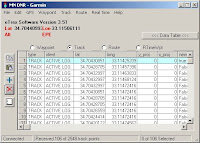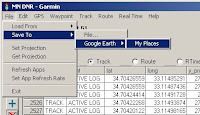
14 nautical miles
I set out in the opposite direction today - south rather than north or east. The wind was light - very light - Bft 2 much of the day.
Almost nobody from the nautical club was out sailing. As we arrived the kayaks were just coming in, but it looks like we were the only people out sailing today. We... that is Raed was my crew again today.
Going south from the nautical club always concerns me somewhat as there are a couple of plastic pipes floating in the water among the buoys for taking off oil/gas/petrol. The pipes do have marker buoys, but the pipes are black and not very visible so I am always concerned that I will miss it and sail into one of them. I'm not sure if I will do
Galini or the pipes more damage. Either way I don't want to find out. If the pipes were white or orange they would be much clearer to see and less dangerous.

As we passed the port entrance light to the commercial harbour I noticed that the port light was protected by an inordinate amount of barbed wire, yet the starboard light appeared almost unprotected.
Changing the bulb for the port entrance light would be a major task - getting over all that barbed wire.

Passing the harbour breakwater I remarked how many yachts there were out sailing today.
The wind was pushing us along at about 3 knots... not exactly exciting sailing, but the water was smooth and it looked like it would be a very enjoyable sail. We swapped helming back and forth so it was good experience for Raed. I remember a couple of years back - what you need is just many many hours of helming.

Coming alongside the first yacht [which was obviously the back of the fleet] we found that there was a race for the Larnaca Offshore Sailing Club... 'We're number one', they told us. So we tagged along to see where they were going.
Strange... we overtook them with no trouble, yet they are a much bigger boat than us, but
Galini has always sailed well in light winds. Now I see she sails faster than yachts double her size.

Leaving 'Number One' in the distance we caught up with
Summer Wine, a Moody 38. Now this is a beautiful yacht. Modern, but classic.
She wasn't quite as easy to pass, but we did and then for the next few miles it was interesting watching where she tacked and where we tacked to stay clear of the airport. We were slowly pulling away from her.
Looking at the waypoints on the GPS I wondered if we would get to Cape Kiti - we got to about 4.5 miles from the cape but the wind was so light it would have taken us nearly two hours to sail there... two hours back and...

Over the airport a dark cloud base was forming. I thought I heard a murmur of thunder, but it could have been a jet taking off. I keep a careful eye on the clouds.
I get a phone call from a friend at the airport saying that he had driving though showers coming up to Larnaca from Limassol and wondered if we had any rain yet. No, not yet...

We head on south taking a big tack out to see if we can get a line down to the cape.
We are overtaken by our first yacht - a Beneteau First 31 - another terrific looking yacht. Small and sleek. That is something about the size I would like.

As we tack in towards the coast we see the clouds creating an amazing stripe effect with the sun over a dredger working at the southern end of the airport. Today is 'Ohi Day' - a public holiday so its slightly strange to see people working today.
On the tack back out I start the Japanese assistant - we have not had enough speed for the self-bailers to take the water out. So I motor sail for about 10 minutes to get up enough speed to clear the water out from the bilges. I think I could do with a manual bilge pump for next year.

We'd heard all the race chat on channel 72, but since neither of us speak any Greek it was all incomprehensible... the only words understood being 'committee boat... committee boat...'.
But, we spot the marker buoy they are all turning around so guess what is happening from that.
Don't ask me why the yacht on the right is sailing so far past the buoy! I know there is a penalty for hitting the buoy, but that is being a bit over careful.

A ketch motors up to past the buoy - getting closer to us than I would like - we're sailing, they're motoring, we have right of way! The skipper [sailing solo with no crew] yells something about playing with the other yachts and gets his jib up, but a few minutes later takes it down again and motors back.
The other yacht launches its spinnaker. I'm not sure how experienced they were with spinnakers - it collapses many times and the pole doesn't look set right - but I cannot talk I have never sailed with a spinnaker!
 Sea Quest
Sea Quest on the other hand has a beautifully set spinnaker. However, goosewinged we overtake her. Time to put on a waterproof as I sense rain might be on its way and its easier to put it on under the buoyancy aid while the sea is calm and sailing easy.
I phone Roy [who has a flat on the sea just north of Mackenzie Beach] and Raed waves to him. He goes for his binoculars and then tells me I need a shave!
In the middle of the call, the wind changes, backing the genoa which is goosewinged, so I quickly close the call and tend to the boat.
We hear a thunder clap and see lightning over the airport. Definitely time to make for home. No, we didn't manage to catch the lightning in the photo. And no, it didn't hit the plane!


The Beneteau is also goosewinging it back - I kind of like their idea for holding the boom out to stop an accidental gybe... but I'm not sure how safe it is! I would have thought a line from the end of the boom to the pulpit would be safer.
When goosewinging I try to keep it so that the main is held out solid and the genoa is on the edge, so I watch the genoa for any signs of luffing as an indicator to bear off very slightly.
We overhaul them slowly. Of course I have an advantage - I have pulled up my centreboard, which they cannot do with their keel.
The light is really strange by now - thunder and rain on one side, light overcast where we are and sunshine in the distance.

The rain eventually catches us and out come the waterproofs on the yachts. With the rain, we get an increase in the wind and suddenly we're doing 5 knots or more... goosewinged... gusting and the whole rig rattles with each gust... back through the plastic pipes which are now very close to invisible in the darkening sea!
I must find out what to do with gusts when you are sailing goosewinged. You cannot easily bear into the wind or spill wind...
All in all it was a very enjoyable sail.
 Today I sailed with Sophocleus - one of the guys from the Day Skipper course in Limassol. Tim took out his trimaran and the two boats sailed together down to Mackenzie beach. Water spots on the lens... sorry!
Today I sailed with Sophocleus - one of the guys from the Day Skipper course in Limassol. Tim took out his trimaran and the two boats sailed together down to Mackenzie beach. Water spots on the lens... sorry!
















































